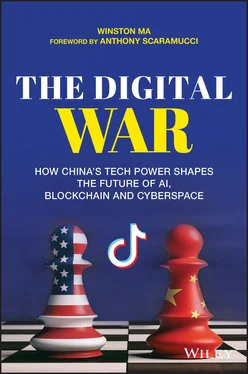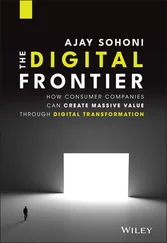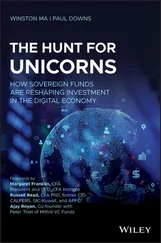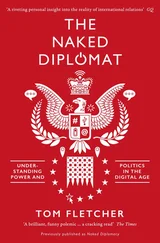CHAPTER 1 China's Leap into 5G iABCD
Blockchain with Chinese Characteristics
AlphaGo, the Historical Match
AI First—“Second Half Game” of Mobile Internet
5G iABCD New Infrastructure
Digital Transformation in the Cloud
BaaS Startup Innovation Ecosystem
Splinternet and the Digital Silk Road
Blockchain with Chinese Characteristics
Since the coronavirus became a pandemic and people dived into remote working in March 2020, video-conferencing services have become vital components of this new way of life. Zoom, an until then little-known online platform, has emerged as the go-to service for not only virtual meetings and classroom lessons, but also church services, costume parties, romantic dates, and even wedding ceremonies. Zoom has quickly become the No. 1 video-conferencing platform in the United States, more popular than similar offerings from Google, Microsoft, and Facebook. Between December 2019 and April 2000, Zoom's daily meeting participants jumped 30-fold to 300 million in a mere five months.
Whereas Zoom is headquartered in the United States and listed on the Nasdaq exchange, the actual Zoom app appears to have been developed by companies in China. In its Securities and Exchange Commission (SEC) filings, Zoom has at least 700 employees who work in research and development out of its affiliated companies in China. The company founder is a native Chinese who had working experience at the US telecom giant Cisco. When Western corporations flocked to Zoom it could well have been their first time to use Chinese enterprise-solution software in their businesses. In the past, the US and European markets mostly learned about China's booming digital economy from the billion users of WeChat (the WhatsApp of China), mind-boggling e-commerce volume of Alibaba, or the goofy videos of TikTok.
Most of them, however, probably have missed a much bigger technology breakthrough in China in the same month, which further illustrates China's digital economy prowess—in the form of “hard tech” innovation—way more than pure mobile applications connecting online users. After more than six years of preparation, in April 2020 People's Bank of China (PBOC, the central bank) unveiled to the public its new digital currency, the world's first central bank digital currency (CBDC), known as the Digital Currency/Electronic Payment (DCEP), which could replace cash with a blockchain (like)-based solution.
Most likely, DCEP makes China the first major economy to adopt a native digital currency. DCEP is designed to function as the digitalization of physical cash (i.e. paper cash, coins, and banknotes) or just as the substitution of the base money supply (M0)—at least for now. Progress on the DCEP was broadly viewed as a reaction to Facebook's announcement in 2019 that it intended to launch Lybra , Facebook's planned blockchain-based digital currency, which is still trying to win approval from regulators. Unlike Bitcoin and other cryptocurrencies, built on the excitement regarding “decentralization”, DCEP is run from a centralized database; nevertheless, DCEP is built with blockchain and cryptography, and it has incorporated blockchain's key concepts, such as peer-to-peer payment, traceability, and tamper-proof-ness (see Figure 1.1).
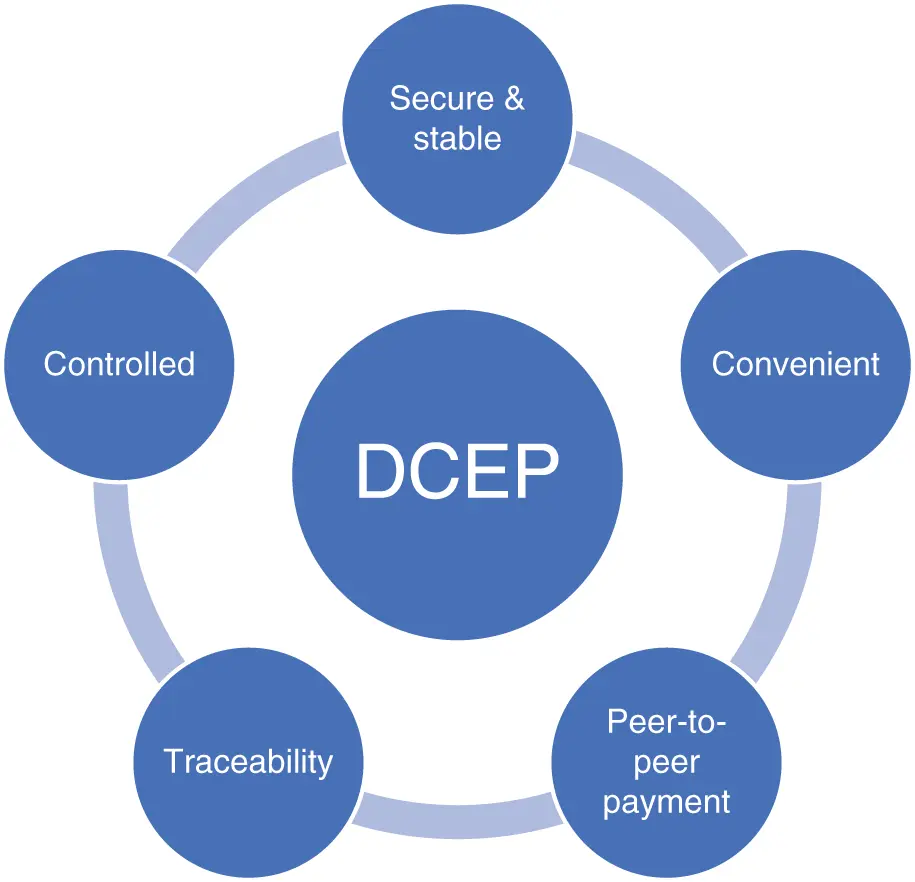
Figure 1.1 How is DCEP designed?
Data Source: Media Reports, April 2020.
Since its April launch, the new digital currency has been piloted in four major cities, Shenzhen, Suzhou, Chengdu, and Xiong'an New Area, the city to replace Beijing as the country's capital. (Leveraging the blockchain technology's strength in data management, the whole city of Xiong'an has a blockchain DNA. See the “Vice Capital Built on Blockchain” box.)
In the pilot zones, DCEP has been formally adopted into the cities' monetary systems, with some government employees having started to receive their salaries in the digital currency in May 2020. People can create a DCEP wallet in their commercial bank's mobile app and use the national digital currency for expenses like transportation, education, healthcare, and other consumer goods and services. Starbucks, McDonald's, and Subway chains in China, for example, were named on the central bank list of firms to test DCEP. In July, Chinese ride-hailing giant Didi Chuxing entered a strategic partnership with the PBOC to test DCEP on its transport platform of over 500 million users. In August, China expanded DCEP trials to Beijing and several major cities—getting even closer to its official launch.
Vice Capital Built on Blockchain
Billed as “a strategy crucial for the millennium to come,” the Xiong'an New Area is a new area of “national significance” launched by China on April 1, 2017, following the Shenzhen Special Economic Zone in the 1980s and Shanghai Pudong New Area in the 1990s. Designed for taking over “non-capital functions” from the hyper-crowding of Beijing, Xiong'an (meaning “brave and peace”), located about 100 km southwest of Beijing, will be a new home—a “vice capital”—for Beijing's colleges, hospitals, financial institutions, and state-owned enterprises' headquarters.
As China's “city of the future”, Xiong'an has been designed to become a smart city zone for innovation. In this context, the integration and application of the Internet of Things (IoT) technologies, artificial intelligence, Big Data, and cloud computing has been strongly encouraged in the city planning. In particular, the new city is set to become the blockchain hub in China and has taken a lead in rolling out blockchain-based services.
The blockchain DNA of the megacity had started even before its construction. To build the vice capital over swampland, the government purchased land from local farmers. Those transactions are made via blockchain to keep them transparent and organized. The so-called Blockchain Land Compensation Distribution Platform distributes financial subsidies for relocated residents in the area. Since April 2020, DCEP, the blockchain-based digital currency, has been tested at hotels and convenience stores in the New Area.
In order to create a “beautiful forest to last a thousand years”, every tree in Xiong'an will have its unique identification after being planted. The Xiong'an project team has built a system powered by blockchain, Big Data, and cloud computing technology to track the whole process for quality control, including seedling selection, excavation, packaging unloading, planting, and irrigation. Based on this system, each tree has a digital ID. After being encoded, all of its information, including its species, place of origin, planting location, and growth status, can be found in the database.
In parallel, as a model of “transparent Xiong'an”, a blockchain-powered funding management platform is used to monitor the flow of cash and ensure the funds will be used exclusively for the digital forest project. The blockchain platform also tracks each worker's activities and directly pays salaries to their bank accounts. By the end of 2019, Xiongan had planted 14 million trees—on the blockchain.
China's DCEP has set off a global debate for its future potential to challenge the US dollar for primacy. To some, DCEP—the world's first central bank digital currency (CBDC) for a major country—may provide a functional alternative to the dollar settlement system that reigns supreme in the global economy for decades. For example, China could use DCEP to manage funding and transactions for its Belt and Road Initiative (BRI) of overseas infrastructure investments, extending its monetary sphere of influence.
Читать дальше
